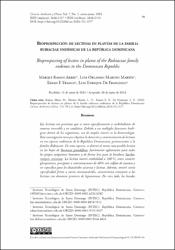| License | Creative Commons Attribution-NonCommercial-ShareAlike 4.0 International License. | es |
| Author | Ramos Abreu, Marqui | |
| Author | Maroto Martín, Luis Orlando | |
| Author | Franco, Edian F. | |
| Author | Rodríguez-De Francisco, Luis Enrique | |
| Accessioned date | 2024-08-23T21:48:00Z | |
| Available date | 2024-08-23T21:48:00Z | |
| Year | 2024 | |
| Citation | Ramos Abreu, M., Maroto Martín, L. O., Franco F., E., De Francisco, L. E. (2024). Bioprospección de lectinas en plantas de la familia rubiaceae endémicas de la República Dominicana. Ciencia, ambiente y clima, 7(1), 99-122. Recuperado de: | es |
| URI | https://bvearmb.do/handle/123456789/5059 | |
| Abstract | [Español] Las lectinas son proteínas que se unen específicamente a carbohidratos de manera reversible y no catalítica. Debido a sus múltiples funciones biológicas dentro de los organismos, son de amplio interés en la biotecnología. Esta investigación tuvo por objetivo la detección y caracterización de lectinas en tres especies endémicas de la República Dominicana, pertenecientes a la familia Rubiaceae. De estas especies, se detectó al menos una posible lectina en las hojas de Stevensia grandiflora, fuertemente aglutinante para todos los grupos sanguíneos humanos y de forma leve para la levadura Saccharomyces cerevisiae. La lectina mostró estabilidad a 100°C, tener carácter glicoproteico, precipitar a concentraciones de 40% con sulfato de amonio y ser específica para los disacáridos sacarosa y lactosa. Además, mostró cierta especificidad frente a varios monosacáridos, característica semejante a las lectinas con dominios proteicos de leguminosas. Por otro lado, las bandas visualizadas en la electroforesis SDS-PAGE, en condiciones reductoras, demostraron la posible estructura monomérica o dimérica de la(s) lectina(s) detectada(s). Estos resultados representan nuevas lectinas para la tribu de rubiáceas Rondeletieae, con el potencial de servir como herramientas en biotecnología y medicina. | es |
| Abstract | [English] Lectins are proteins that specifically bind to carbohydrates in a reversible and non-catalytic manner. Due to their multiple biological functions within organisms, they are of wide interest in biotechnology. The objective of this research was the detection and characterization of lectins in three endemic species of the Dominican Republic, belonging to the Rubiaceae family. Of these species, at least one possible lectin was detected in Stevensia grandiflora leaves, strongly agglutinating for all human blood groups and weakly for the yeast Saccharomyces cerevisiae. The lectin showed stability at 100°C, had a glycoprotein character, precipitated at 40% concentrations with ammonium sulfate, and was specific for the disaccharides sucrose and lactose. In addition, it showed some specificity against several monosaccharides, a characteristic like lectins with legume protein domains. On the other hand, the bands visualized in the SDS-PAGE electrophoresis, under reducing conditions, demonstrated the possible monomeric or dimeric structure of the detected lectin(s). These results represent new lectins for the Rubiaceae Rondeletieae tribe, with the potential to serve as tools in biotechnology and medicine. | es |
| Language | Spanish | es |
| Published | Ciencia, ambiente y clima, 7(1), 99-122 | es |
| Rights | © Ciencia, ambiente y clima, 2024. | es |
| Rights URI | https://creativecommons.org/licenses/by-nc-sa/4.0/ | es |
| Subject | Biotecnología | es |
| Subject | Flora ─ República Dominicana | es |
| Title | Bioprospección de lectinas en plantas de la familia rubiaceae endémicas de la República Dominicana | es |
| dc.title.alternative | Bioprospecting of lectins in plants of the Rubiaceae family endemic to the Dominican Republic | es |
| dc.identifier.doi | https://doi.org/10.22206/cac.2024.v7i1.3177 | |
| Material type | Article | es |
| Type of content | Scientific research | es |
| Access | Open | es |
| Audience | Technicians, professionals and scientists | es |


